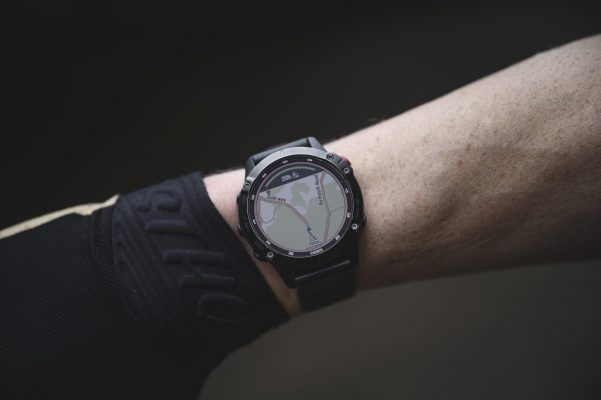The Garmin Fenix 6 Pro Solar is a watch of superlatives, the most functional, accurate, reliable and impressive watch Garmin has made. It’s also the most expensive.
Garmin Fenix 6 Pro Solar Edition smart watch review
The Garmin Fenix 6 Pro Solar Edition is a GPS smartwatch that’s jam packed with features, starting with a choice of models that already frazzles your brain before you’ve even started to unpick the features. There are six sizes to choose from, three spec levels, and multiple colours and strap options, with this Pro Solar packing in the ultimate features like a 1.4in screen. I went for the middle sized case at 47mm and found it far more comfortable than the old Fenix 5, with a snug and secure fit that didn’t leave my wrists sore.
Read more: Best XC race bikes – hardtail and full suspension

The big colour screen offers enough detail to follow a GPX route by, as well as displaying the usual ride metrics like speed, ascent, heart rate and so on
The original Garmin Fenix was an impressive piece of technology, released in 2012 it wowed us with its colour map, heart rate monitor (via a chest strap) and its ability to sync with the latest and greatest iPhone 5. Nearly 10 years later, Garmin has been through six iterations of the Fenix to arrive at the new Pro Solar, and the list of new functions is just as impressive: blood O2 saturation monitoring, weather forecasting, solar charging, recovery time, we could go on forever. The big question though, is all this data and analysis worth the £700 outlay?
This is actually more important than just aesthetics because a good fit helps to ensure more accurate blood oxygen and heart rate readings, some of the most useful settings on this watch. The Fenix 6, like all smartwatches, reads this information by shining LED lights into your wrist – external light and excessive vibration distorts the data.
There isn’t space on the internet to tell you all the widgets (think apps) you can look at on the Fenix 6, but the most important ones for riders are: GPS ride tracking, heart rate and heart rate variability, oxygen saturation, and breathing rate. From that data (and more besides, like temperate, altitude, humidity and so on) the watch uses its algorithms to try and figure out just how hard you’ve worked on a ride, and the effect that’ll have on your fitness. This is pretty much the goal of the Fenix 6, it’s a sports watch designed to help you train and ride (or run, swim, play golf and so on) smarter. You can flick through these widgets quickly and easily on the home screen, and while it’s not touch screen it’s very easy to navigate.
Naturally I tracked my rides in the MTB mode, and the Fenix 6 delivers all kinds of real-time information like speed, heart rate so you can sit in just the right training zone, and ascent. It’s also very competent at delivering a turn-by-turn navigation setup, the 1.4in screen is just about big enough to guide you around an off-road route although a bar mounted computer will always be better at this. Incidentally, you can actually get a bar mount for the Fenix 6 for £35. The guide-me-home function was also super useful for wilderness ramblings.
In terms of GPS accuracy the watch is the best I’ve tried, measuring my rides accurately without overreaching or under recording, like the Wahoo Elemnt, which had a nasty habit of digitally dropping me off the trail or into a lake. It’s a huge improvement on the Fenix 5 too, which would add diversions that never actually happened. The Fenix 6’s heart rate sensor is also very good and, for the most part reliable, with just the occasional glitch. Heart rate is noticeably more accurate than Garmin’s cheaper Vivoactive 4 watch or the Fenix 5, despite both using the same sensor and technology that the brand dubs Elevate.

Want to know what it all means? No problem, Garmin’s app will break down your ride and display a Training Effect, as well as where you need to improve
It’s off the bike that things get really interesting though, the Fenix 6 automatically syncs the data to an app on your phone, and also to Strava or any other app you’ve asked it to send it to. It can take a few hours to do this, but in the mean time you can still see all the details of the activity on the watch face. From the data you’ll see your Training Effect from each ride, telling you if you’ve increased your VO2 max, boosted muscular endurance, base fitness or high aerobic capacity, for example. The Fenix 6 can then recommend different types of rides (faster, shorter, slower etc) to give you a more rounded training. Typically, I was always overdoing it on the high intensity efforts and neglecting the low-intensity workouts that build fitness.
The Fenix 6 will also give you a Training Load score – basically how wasted it thinks you are and how many hours rest you need. This is a fantastic idea, and often correlated well with how I felt after a ride. It’s no substitute for actually taking into account how you feel in the morning though, sometimes I’d be told I was good to go, despite feeling like a day in bed. Conversely, punch out a ride over a couple of hours where your heart rate pushes up to maximum (most decent trail rides then) and the Garmin Fenix 6 will tell you to take four days off. This always felt like overkill for me.

Wrist-based heart rate monitors are limited in their accuracy, but the Fenix 6 is the most exact we’ve seen
Also unnecessary is the Pro Solar function – the watch has a thin photovoltaic bezel and a secondary solar panel underneath the face, all lurking behind the latest Gorilla Glass 3 with DX coating. The idea isn’t to charge up the battery, more top it up. How much juice you’ll get depends on the weather, Garmin says you’ll need to be in full summer sun for at least three hours a day to take full advantage of this, and then it could add a couple of hours run time. For UK riders this function is pretty useless, I found the Fenix 6 would last about six days anyway before needing charging, even recording 2-3 rides in that period. Unless you hike above the treeline somewhere or routinely ride off-grid in the mountains then just downgrade to the cheaper Garmin Fenix 6.
To access details like the VO2 Max score or a Training Status (Recovery, Maintaining, Productive, detraining etc) I also needed to either go running or ride with a power meter, it can’t do it from riding alone as the watch just has no idea how efficient the ride is. While I can’t blame Garmin for this, it demonstrates the lengths you need to go to to get your money’s worth from the Garmin Fenix 6.
Verdict
Boy, this is a very, very expensive watch. And all the functionality actually makes things quite confusing – I’ve been using it for more than four months now and still feel like it could be set up better and that there are parts I’m not even touching. Just be sure you need it all before pulling the trigger, and whether a simple bar mounted computer and heart rate strap might be more useful.
















